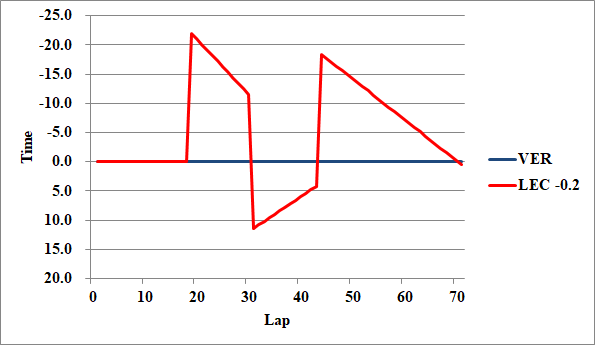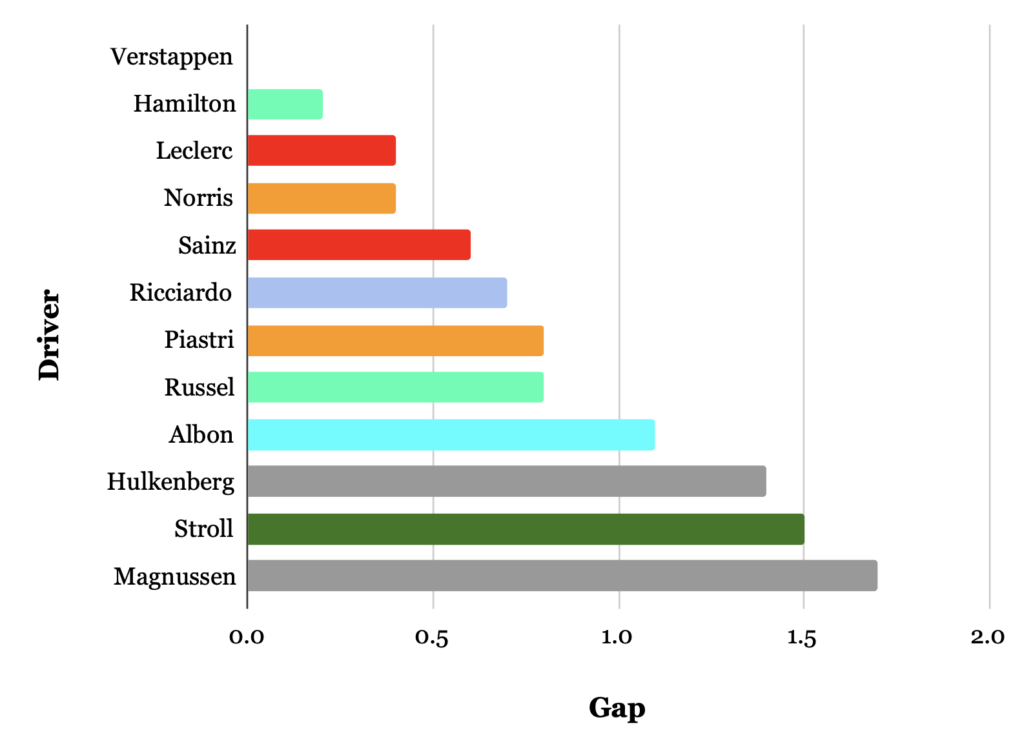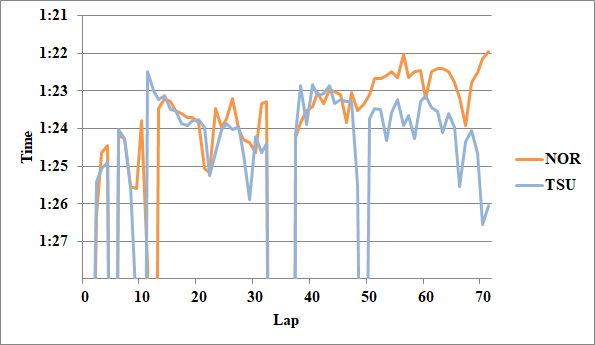
F1 arrived at the Mexican GP, where the high altitude and the thin air pose a great challenge, causing a lack of downforce and cooling issues. The teams brought thick wings similar to Monaco, but they still could only produce about 90% of the downforce they had at Monza.
In this article, we will look back at the race of the challenging Mexican GP from an analytical perspective.
Pirelli’s Official Tyre Strategy for Each Driver
1. The World of ‘What-ifs’
Verstappen nailed the start and took the lead in the first lap. He had already secured more than half of his victory at that point, but it was interesting that he chose a two-stop strategy.
This time, the red flag in the middle of the race prevented us from seeing the scenario of two-stop Verstappen vs one-stop Leclerc. This time, let’s try to simulate what would have happened if there was no red flag.
Fig.1 shows the gap between Verstappen and Leclerc. It’s assumed that Leclerc was 0.2 seconds slower than Verstappen according to the race pace analysis that I’ve done already.

When Verstappen pitted on lap 19, he quickly closed the gap with his tyre advantage. Then, when Leclerc pitted, Leclerc started to catch up Verstappen. And, when Verstappen finished his second pit stop on lap 45, he again used his tyre advantage to chase and overtook him on lap 55.
By the way, in the actual race, Leclerc returned to the track 17 seconds behind Verstappen after his pit stop before the red flag, which is almost same as this simulation graph.
Therefore, if there was no red flag, Leclerc would have been leading until at least approximately 15 laps from the end, and it would have been a more interesting race.
However, the reason why Red Bull and Verstappen chose a two-stop strategy was probably because they had confidence in their pure pace. Here, Fig. 2 shows the simulation graph of what would have happened if Leclerc had the same pace as Verstappen under the same conditions.

The result was that the overtaking would have happened on the final lap, and it would have been a very tight battle. In that case, it would have been better to take advantage of the track position and adopt the same strategy as Leclerc to increase the chances of winning.
This shows that Verstappen’s pace advantage over his rivals allows him to adopt a flexible strategy, and that protects them from various risks in the race. This situation is similar to that of Schumacher & Ferrari in the 1990s and 2000s, and when a team can win with their whole team. In front of such superiority, there is almost nothing that rival teams can do.
Given their form, Verstappen and Red Bull might even surpass their record of 16 wins in a season next year. They are so unstoppable and truly creating an era of their own.
2. Expectations for AlphaTauri in the Final Races
On this website, we calculate each car’s pure performance by taking into account tyre degradation, fuel effect, and race context. The result of our race pace analysis for this race is shown in Fig. 3. For Tsunoda’s pace consideration, we also show Norris and Tsunoda’s race pace in Fig. 4.


Ricciardo’s pace was astonishing, outperforming both Russell and Piastri and being just 0.1 seconds slower than Sainz.
On the other hand, Tsunoda’s pace was impossible to clarify quantitatively, but qualitatively there are some things we can say.
Firstly, in his second stint, he was able to keep up with Norris on the same hard tyres in the first half of the stint, but before the red flag Norris picked up the pace while Tsunoda slowed down. FYI, other fast laps were effected by DRS usage during overtaking, but there was none of that in the lap just before the red flag, so it reflect pure pace.
Taking this into account, even considering that Norris had tyres that were two laps (equivalent to 0.2 seconds if degradation is 0.10 [s/lap]) newer than him, it is clear that his pure pace was not as good as Norris.
On the other hand, in his third stint, he was aggressive against Piastri, even though the hard tyres were more advantageous. Therefore, he was at least equal to Piastri, or possibly had a better race pace.
Therefore, Tsunoda’s race pace was also close to Ricciardo’s (±0.1 seconds?), and the great pace of both cars must have been very encouraging for them. Especially for AlphaTauri, where Ricciardo securing the fourth position in qualifying suggests that they are finally harmonizing qualifying and race setups, providing a glimmer of hope.
They also moved up to eighth in the constructors’ standings, and they may be the team with one of the brightest prospects for the remaining three races.
3. The Contrast of Fates
This time, Tsunoda, who had started from the back of the grid and chased up with the good pace mentioned above, was expected to take advantage of the big chance that came with the red flag. However, he collided with Piastri when overtaking him, and dropped out of the top fight.
At that moment, despite Piastri being alongside him as they braked into the corner, Tsunoda turned his steering wheel, aiming to hit the apex of Turn 1 with an aggressive line. Such an approach almost certainly leads to a collision.
By the way, Piastri could not back off or move to the inside to avoid the collision at that time. If Piastri wanted to change his line, he would have to ease off the brake. He could not apply lateral force to turn the car when the tyre grip was all used for braking. If he did that, he would not have been able to stop at turn 1 and consequently also collide with Tsunoda.
We can see this case in the 2001 Austrian GP. Schumacher intimidated Montoya with his braking, and Montoya could not stop and ended up pushing Schumacher out.
Video: Schumacher And Montoya Battle In Austria | 2001 Austrian Grand Prix (1:16~)
Also, after the contact, he ran in clear air until lap 57. If you look at Fig.4, his time was not stable during that period. There may have been some damage, so we will not comment on the absolute pace, but he needs to be able to set consistent lap times as if nothing had happened from the next lap after the contact. This will undoubtedly be a challenge for Tsunoda as he progresses in his career.
On the other hand, Norris’s race, which was also a chase from the back of the grid, was brilliant.
Especially the restart after the red flag was very impressive, as he slowed down and avoided contact when he was sandwiched by Hulkenberg and Albon on the straight. He lost four positions by doing this, but considering that he would not have finished fifth if he had not backed off, no one will question whether this decision was correct or not.
He continued to overtake his rivals one after the other, showcasing an aggressive yet calculated driving style, demonstrating his quality as a top driver.
By the way, Ricciardo, who battled with Norris, was also great. The battle from turn 4 to 6 was very creative and close, but he fought fairly. And on the final lap, he brought Russell side by side, but backed off where he had to and secured seventh place (6 points). It was amazing that he could make a calm decision when sixth place was just in front of him, and he would clearly be a good role model for Tsunoda. I look forward to seeing what Tsunoda will learn from Ricciardo as a teammate in the next three races.
Writer: Takumi